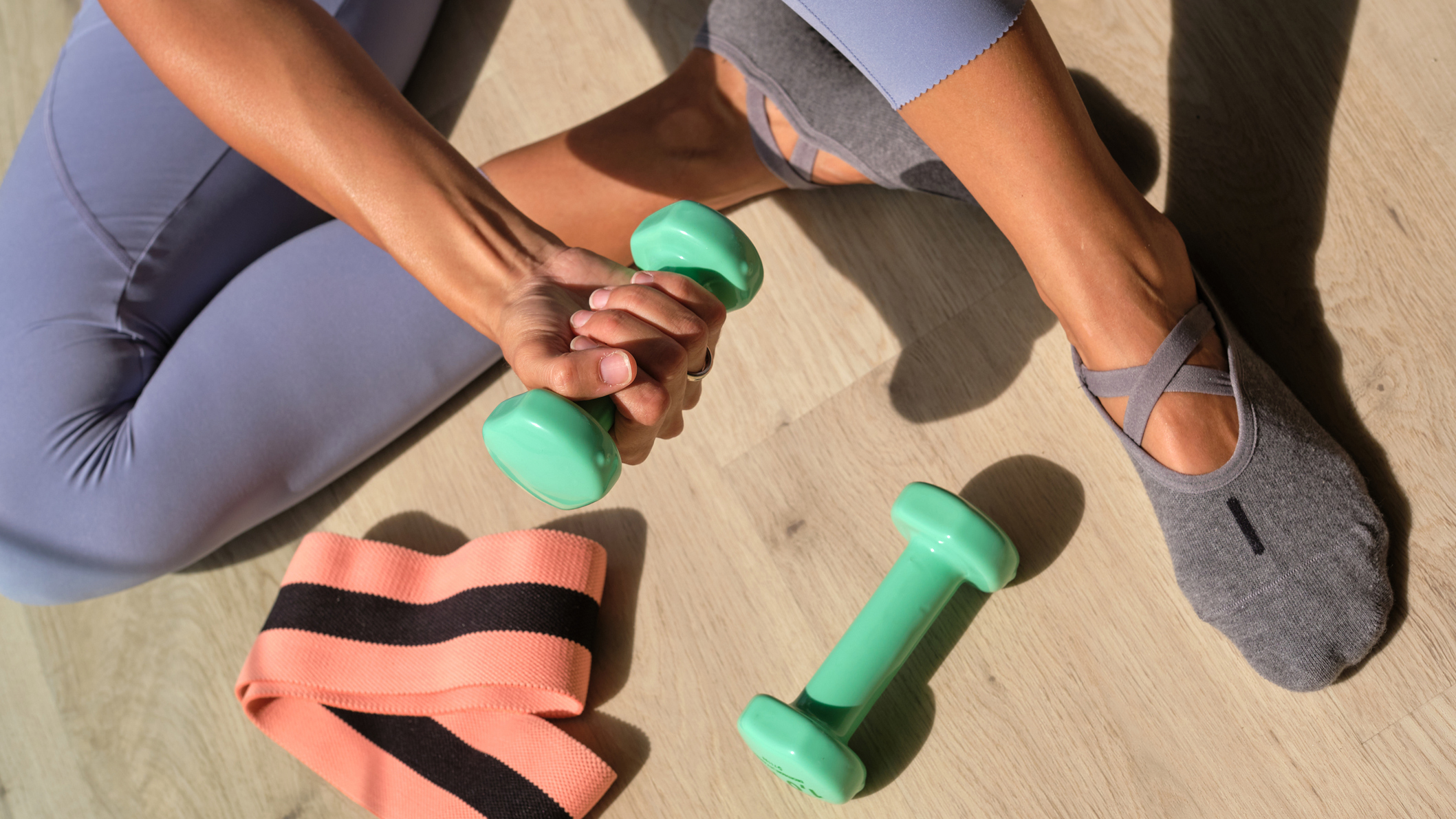A top NASM trainer recommends beginners do these three moves to build full-body strength efficiently
You can use these three favorites from NASM master trainer Wendy Batts as a workout or individual exercise snacks


Expert advice usually comes at a price, but we like to do things differently at Fit&Well.
That’s why you can have this beginner strength training workout from National Academy of Sports Medicine (NASM) master instructor Wendy Batts for free.
It features three total-body moves, and all you need to give it a go is 15 minutes, a light dumbbell, and a resistance band.
How to do Wendy Batts’ three-move workout

- Single-leg Romanian deadlift, curl to overhead press 3x12-15 on each side
- Squat to resistance band row 3x12-15
- Incline push-up with rotation 3x12-14
Perform the three exercises above as a circuit, taking a few deep breaths between each one. Repeat this sequence for three total rounds for a quick full-body workout.
"Take each exercise at a slow pace, focusing on form and intentional movements, and you’ll get a lot of bang for your buck," says Batts.
She also says you can use these moves as exercise snacks if you prefer, doing a few repetitions here and there throughout your day—a particularly handy approach if you work from home.
"People always say that time is an issue, but even if they just do a few of the push-up rotations or squats to rows, they’re doing a lot in a short amount of time," says Batts.
Start your week with achievable workout ideas, health tips and wellbeing advice in your inbox.
"Do this a few times throughout the day and you end up working a lot of different muscles. It also means you’re moving more and not sitting down all day."
1. Single-leg Romanian deadlift to biceps curl to overhead press
Sets: 3 Reps: 12-15
- Stand upright with your feet roughly hip-width apart, toes forward and a dumbbell in your left hand. Lift your left foot just above the ground so you’re balancing on one leg.
- With a soft bend in your right knee and your left arm hanging straight down toward the floor, hinge at the hips to lower the dumbbell toward the ground. As you do this, allow your left leg to lift behind you as a counterbalance.
- Lower the dumbbell as far as you can control while keeping a flat back, then squeeze your glutes (the muscles in your backside) to stand up straight.
- Curl the dumbbell up to your left shoulder, keeping your elbow tucked to your side as you do, then press it overhead.
- Reverse this motion to return to the starting position. That’s one rep.
Trainer tips
This might seem like a complex exercise for beginners, challenging your balance as well as your muscles. But that's all part of the plan.
The NASM's Optimal Performance Training model lists stabilization—developing proper movement patterns, along with stability and mobility of the body—as the foundation for successful future strength training.
By standing on one leg throughout this exercise, the emphasis switches from lifting a heavy weight to maintaining postural control, balance and stability in your joints and core.
But you're still using a lot of muscles and working through three of the fundamental movement patterns; a hip hinge (the Romanian deadlift), a pulling motion (the biceps curl) and a pushing motion (the overhead press).
"You’re hitting multiple muscles including the glutes, quads and the arch support in your foot, as well as doing the curl and overhead press for your arms and shoulders," says Batts.
"You don’t need anything besides a light dumbbell, and if you’re just working on your balance you can do it with just your bodyweight before adding load as you grow more comfortable with the movements."
Batts adds that, if you don’t have a dumbbell, you can use another household object like a tin of beans or a full water bottle.
2. Squat to resistance band row
Sets: 3 Reps: 12-15
- Loop a resistance band or tubing around a secure anchor point in front of you, then stand facing it with one end of the resistance band in each hand. You should stand far enough away that the band is taught and your arms are fully extended in front of you.
- Perform a squat, lowering yourself as far as you can control while keeping your chest up, then driving through your feet to return to standing.
- At the top of the squat, perform a row by pulling the two ends of the resistance band to your rib cage, keeping your elbows close to your sides. Then slowly allow your arms to extend in front of you again.
Trainer tips
"I’m a big fan of total-body moves, and this is another one," says Batts.
"By going from a squat to a row, you’re working your quads, glutes and back muscles."
Resistance bands are available in a range of different thicknesses and resistances.
"You need to start with the resistance that’s best for you, then as you progress you can get heavier resistance bands and challenge yourself even more [otherwise known as progressive overload]," says Batts.
"But first and foremost you need to focus on form. Think about standing up straight and coming out of that squat, squeezing your glutes at the top. Then, for the row, focus on bringing your shoulder blades down and back, so they feel secure.
"This exercise is especially helpful for anyone weak in the glutes and mid-lower back, which is almost everyone."
3. Incline push-up with rotation
Sets: 3 Reps: 12-15
- Place your hands against a sturdy surface like a weight bench, wall or strong table. The higher your hands are, the less demanding this move will be.
- Get into a hands-elevated high plank position, with your weight spread between your hands and your toes. Your hands should be roughly underneath your shoulders, and your body should form a straight line from your head to your heels.
- Keeping your core tight and your elbows close to your sides, lower yourself until your chest is roughly an inch from the bench, then push through your hands to return to the starting position.
- From here, lift your right hand and rotate your torso, reaching your right hand away from you so your arms form a straight line.
- Return to the starting position and repeat on the other side.
Trainer tips
You can do this move with a standard push-up if you want an extra challenge. Dropping your knees to the floor or having your hands on an elevated surface will make it slightly more accessible.
Like the standard push-up, it will strengthen the muscles in your chest, the triceps that run down the back of your arms and the anterior deltoids on the front of your shoulders. It will also recruit your core, as you’re effectively holding a plank position throughout. And the benefits don’t end there.
The body moves in three planes of motion; sagittal (up, down, forward and backward), frontal (side to side) and transverse rotational. Most strength exercises are sagittal-dominant, but by adding a twist at the top of each rep the push-up with rotation strengthens your body in the transverse plane.
"Most injuries occur in this plane, so it’s good to practice it," Batts says.

Harry Bullmore is a Fitness Writer for Fit&Well and its sister site Coach, covering accessible home workouts, strength training session, and yoga routines. He joined the team from Hearst, where he reviewed products for Men's Health, Women's Health, and Runner's World. He is passionate about the physical and mental benefits of exercise, and splits his time between weightlifting, CrossFit, and gymnastics, which he does to build strength, boost his wellbeing, and have fun.
Harry is a NCTJ-qualified journalist, and has written for Vice, Learning Disability Today, and The Argus, where he was a crime, politics, and sports reporter for several UK regional and national newspapers.